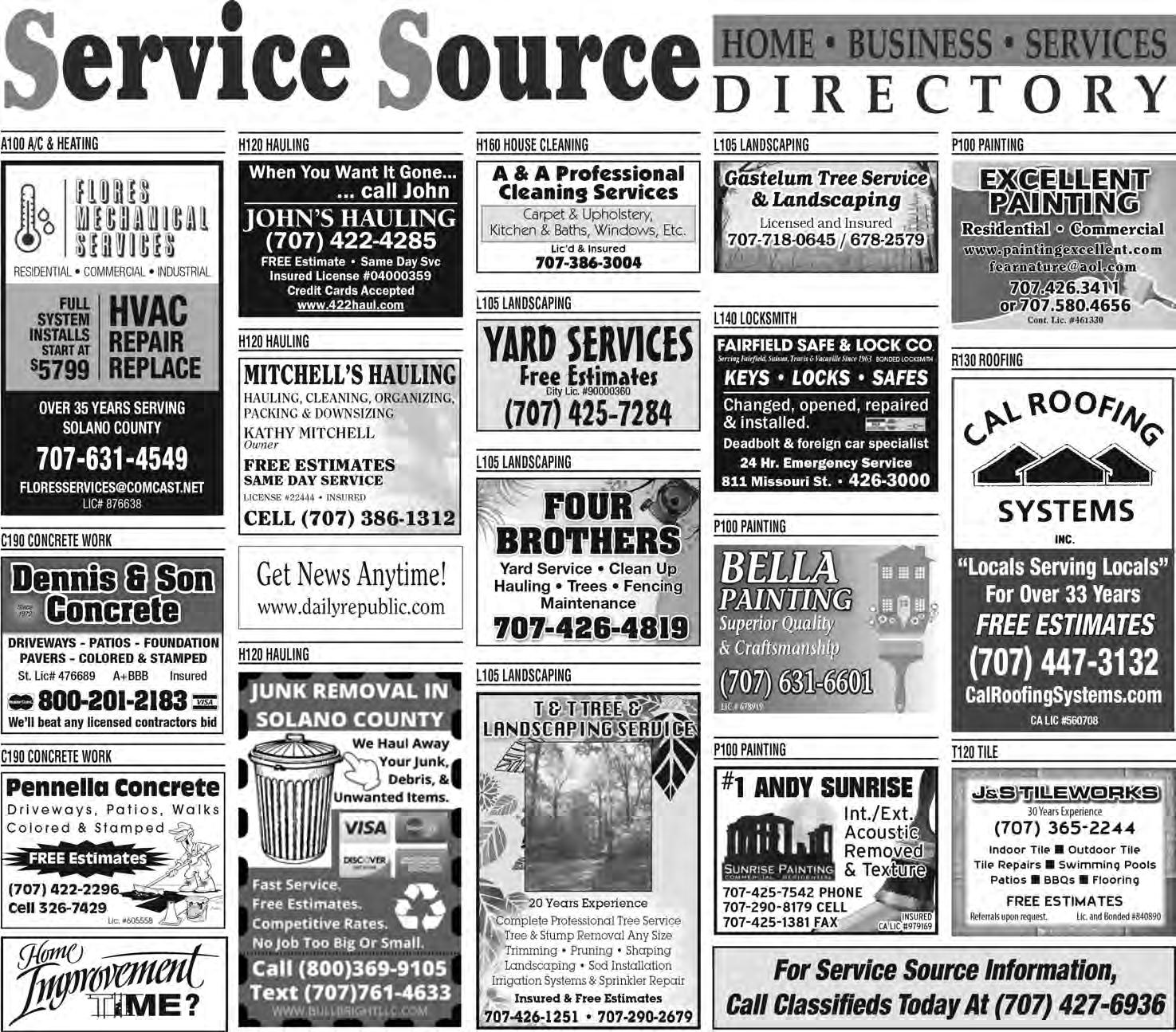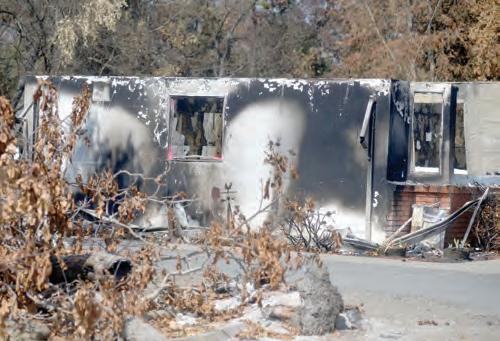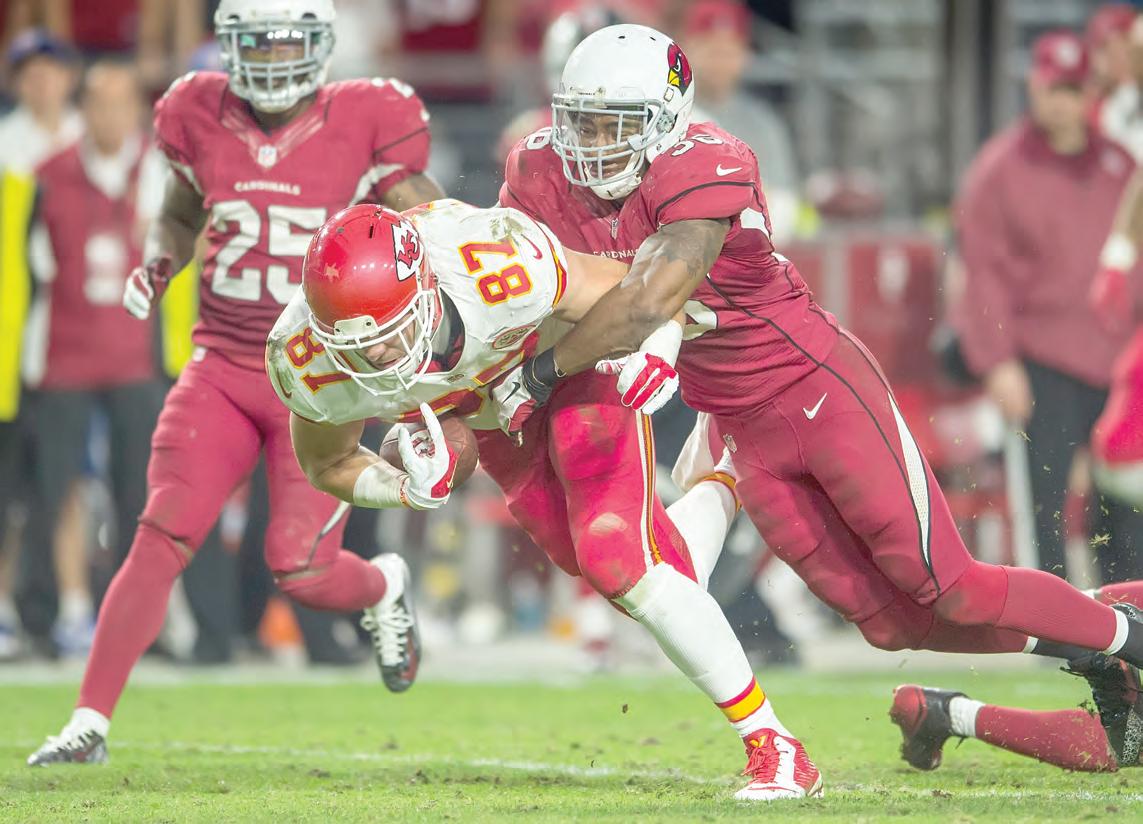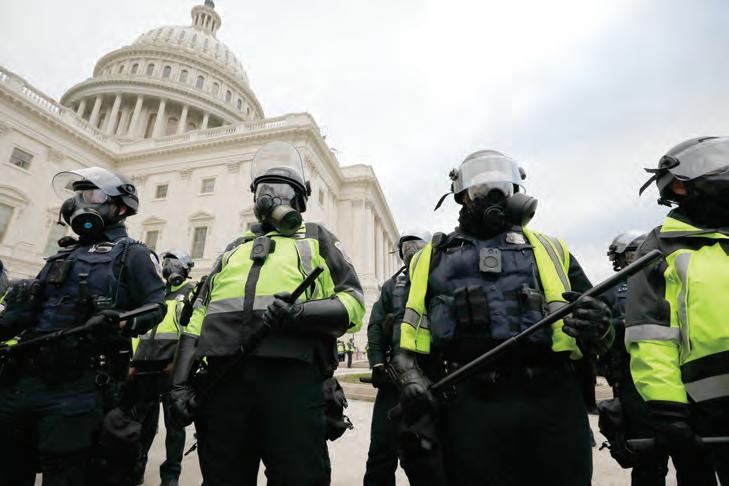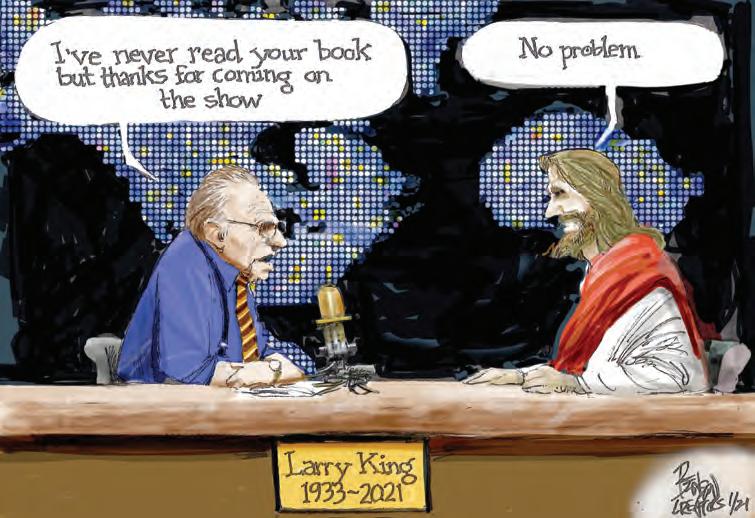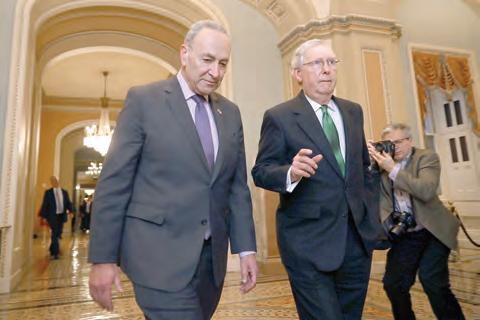
9 minute read
16 16
Newsom’s abrupt reopening brings high risks, potential economic rewards
Los AngeLes Times
Gov. Gavin Newsom’s abrupt move to lift stay-at-home orders – allowing outdoor dining and other business activities to resume – represents a gamble that California can avoid another deadly coronavirus surge in the coming months despite a slow, frustrating rollout of the vaccine and the looming threat of more contagious strains of the virus taking hold across the state.
After a catastrophic falland-winter surge left about 20,000 dead, California is rapidly Saving school year depends on shots for teachers, lower infection rates bending the curve as new cases fall and hospitalizations decline. Covid-19 hospitalizations began to fall about 2½ weeks ago, and much of this progress can be attributed to residents changing their behavior by avoiding travel, staying at home more and following the new rules.
The question now is whether California can keep cases down even as activities such as dining, cosmetology and travel pick up.
Lifting the stay-at-home order should be a boost to some restaurant owners and other merchants whose businesses have been battered by cycles of closure since the pandemic began and who placed enormous pressure on the governor to ease restrictions as campaigns gather signatures to recall him from office.
But experts said it would not take a lot for the situation to spiral out of control again.
UC San Francisco epidemiologist Dr. Kirsten Bibbins-Domingo said lifting the order can work if the public – and businesses – follow the rules and show intense caution. This is more essential than ever, she said, because so much is still unknown about these new strains, which adds a new level of uncertainty to fighting the virus.
“Everything hinges on the behaviors we adopt. If we adopt behaviors where everyone is masking, everyone is keeping to distancing, that all of the rules
Robert Gauthier/Los Angeles Times/TNS Makeshift outdoor dining areas were empty in downtown Covina a few days before Los Angeles County lifted outdoor dining restrictions.
the governor has in place are enforced, I think there’s a possibility for us to resume some of these activities,” Bibbins-Domingo said. “It’s not an outrageous idea. This is not an outrageous policy.”
Newsom, in announcing the changes Monday, also struck a cautious note but said he believed the conditions had improved enough to try it out.
“We’re seeing a flattening of the curve. Everything that should be up is up; everything that should be down is down — case rates, positivity rates, hospitalizations, ICUs. Testing is starting to go back up, as well as vaccination rates in this state,” he said.
The shift took some officials and others by surprise, coming just a few weeks after California found itself the American epicenter of the coronavirus with hospitals overflowing, ambulance patients facing as much as a 17-hour wait to get into emergency rooms, hospital morgues overwhelmed and funeral homes forced to turn families away.
UC Berkeley epidemiologist Dr. John Swartzberg said he feared lifting the stay-at-home order was “premature” because the cases, while declining, remain very high. He said it might make more sense to wait a few weeks until cases go down further and California can begin reopening with a lower baseline.
He noted that after last year’s spring and summer surges, California failed to bring its case numbers to a low level before reopening. That meant that when the next surge hit, it became even bigger than the one before it, he said.
“It’s like we’re climbing this mountain. We go two steps up and we just take one step back, and we take two steps up from there and one step back and we keep just having more cases,” he said. “We’re doing a lot better than we were doing 2½ weeks ago, but we’re doing terrible compared to three months ago. We need to knock these cases down so as we get more and more people vaccinated, we’ll get to a safer environment much more quickly.”
The autumn-and-winter stayat-home order was unpopular in many corners, with some politicians saying it went too far and restaurant owners suing in an effort to bring back outdoor dining. Critics questioned whether there was enough evidence to show outdoor dining was a significant spreader of the coronavirus. But there is evidence the order changed behavior and helped slow the spread.
A calculation by the L.A. County Department of Health Services found that the transmission rate of the virus began to climb in the region in the weeks before Halloween and accelerated until late November, when it reached a peak of 1.2, meaning on average every person infected with the virus was infecting 1.2 other people – a recipe for a dramatic worsening of the pandemic.
It was also in late November that L.A. County became the first in the state in the autumn to shut down outdoor restaurant dining, and a few days later became the first again in the state to issue a stay-at-home order that once again banned almost all private gatherings and instituted tighter capacity limits on stores. The county’s model suggests that was the time period when the transmission rate began to fall, and by late December fell below 1, meaning that every infected person on average was infecting fewer than one other person.
“I think that the early action taken by L.A. County as cases began to rise has blunted the magnitude of this tsunami that we experienced. It would have been even worse had some of these measures not been taken early on,” said Dr. Robert Kim-Farley, medical epidemiologist and infectious diseases expert at the UCLA Fielding School of Public Health, and a former health official with L.A. County.
It would end up taking roughly two months for the effects of L.A. County’s health orders to convincingly begin reducing hospitalizations and offering officials confidence to begin reopening businesses. That’s similar to the amount of time it took for the summer’s business restrictions to have a similar impact.
“It takes time from when you initiate a control measure to when you actually see the effects of having that control measure in place” Kim-Farley said.
Epidemiologists said it’s essential health officials keep focused on at least two mutant strains of the coronavirus in California.
Biden acts to expand rollout
Los AngeLes Times
WASHINGTON — President Joe Biden announced Tuesday that his administration will rush additional vaccine doses to states, territories and tribal governments and purchase 200 million more, ramping up its effort to inoculate more Americans, more quickly, as the death toll from Covid-19 continues to rise.
Under the plan, 10 million doses would be distributed each week for the next three weeks, up from the current 8.6 million. Acknowledging that even the increased number of doses is unlikely to meet the vast demand for the vaccine, Biden urged patience and encouraged people to continue to wear masks.
An average of 3,000 people have died of Covid-19 each day for the last week, and the total death toll could surpass 500,000 next month. New variants of the virus are also believed to be more contagious.
Biden said the additional vaccine doses would be delivered this summer, bringing the total purchased to 600 million. Half would be from Pfizer and the other half from Moderna. Because each vaccination requires two doses to be fully effective, the additional supply would be enough to inoculate an additional
100 million Americans.
Los AngeLes Times
LOS ANGELES — Saving the Los Angeles school year has become a race against the clock – as campuses are unlikely to reopen until teachers are vaccinated against Covid-19 and infection rates decline at least threefold, officials said Monday.
The urgency to salvage the semester in L.A. and throughout the state was underscored by new research showing the depth of student learning loss and by frustrated parents who organized statewide to pressure officials to bring back inperson instruction.
A rapid series of developments Monday – involving the governor, L.A. Unified School District, the teachers union and the county health department – foreshadowed the uncertainties that will play out in the high-stakes weeks ahead for millions of California students.
“We’re never going to get back if teachers can’t get vaccinated,” said Assemblyman Patrick O’Donnell, D-Long Beach, who chairs the state’s Assembly Education Committee and has two high schoolers learning from home.
He expressed frustration that educators are not being prioritized by the L.A. County Health Department even as teachers in Long Beach are scheduled for vaccines this week. Although Long Beach is part of L.A. County, it operates its own independent health agency.
L.A. health officials said Monday that there are simply too many people in high-priority categories who need vaccines and too few doses.
Health Director Barbara Ferrer said she hopes teachers in her jurisdiction could begin to be immunized in February or March, but that would depend on the vaccine supply. Last week, local officials estimated it may take until June for those 65 or older to be vaccinated. The last day of instruction for the current school year in Los Angeles is June 10.
In remarks Monday, Gov. Gavin Newsom called vaccines “the light at the end of the tunnel,” and said he was “focused on taking the steps needed to get Californians safely vaccinated as quickly as possible.”
With virus levels still dangerously high, but trending in a better direction, Newsom eased restrictions on businesses and highlighted progress on speeding up the pace of vaccinations, but provided less clarity about when teachers across the state would be immunized.
When asked for clarification, staff in the governor’s office forwarded the inquiry to the California Department of Public Health. That department declined to answer questions, deferring to the governor.
Nonetheless, the importance of teacher vaccinations as a precursor for reopening campuses emerged clearly in statements from L.A. schools Supt. Austin Beutner and in an update from the leadership of United Teachers Los Angeles, which represents more than 30,000 teachers, librarians, counselors and nurses in the nation’s second-largest school system.
“Vaccinations are a critical piece of the puzzle, and we’re all frustrated at the pace of the rollout despite everyone’s best efforts,” Beutner said in remarks broadcast Monday. The L.A. schools chief said immunizations would “not only protect the health and safety of staff but will provide enormous benefit to children and their families with a faster reopening of schools and of the economy.”
Aside from vaccines, there’s uncertainty over how fast coronavirus infection rates can drop in Los Angeles County. Throughout the pandemic, rates have never been low enough to fully reopen campuses. Currently the infection rate in L.A. County is about three times higher than would allow for the reopening of elementary campuses under the latest state directives. The standards for secondary schools are even more out of reach.
Beutner and other education leaders – who are critical of Newsom’s funding plan to get students back in classrooms – said school districts need additional state money to safely reopen and consistent rules on when campuses should do so.
The fast-turning calendar and political pushback against Newsom’s proposal for reopening incentive grants likely mean the plan won’t be ratified in its current form. The Legislature will try to work out something with the governor over the next few weeks, O’Donnell said.
Leaders of the teachers union, United Teachers Los Angeles, essentially agree with Beutner on two critical points for reopening: a significant drop in coronavirus infection rates in communities served by L.A. Unified and teacher vaccinations.


